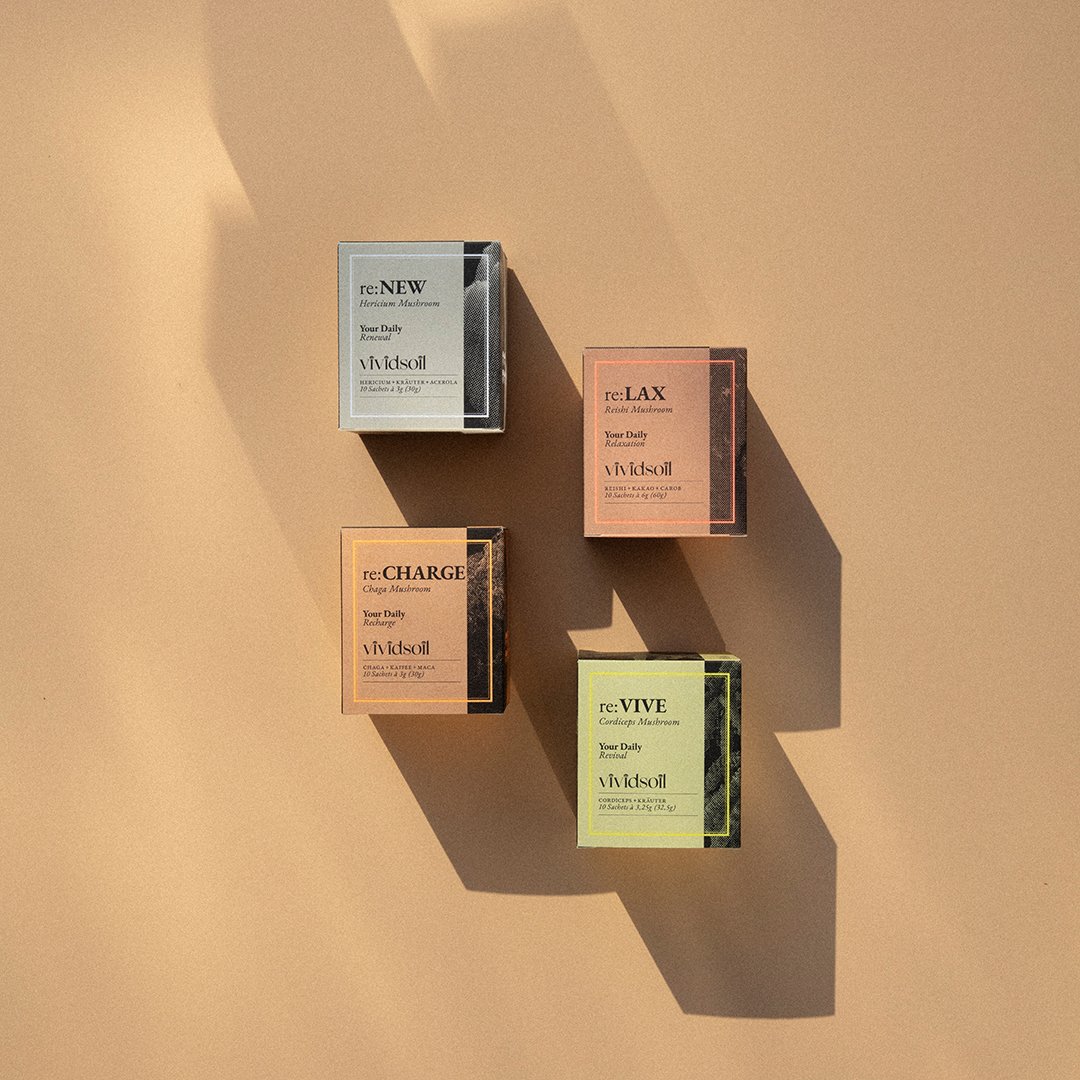The Beauty of Nature: Mushrooms
Mushrooms seem to be everywhere these days. In our coffee, tea, on our dresses and T-Shirts. Today we talk to Vividsoil Co-Founder Moritz Schmid about this mushroom renaissance, where it’s coming from and how certain mushrooms can be incredible tools on our way to health and wellbeing.
Disclaimer: This article discusses medicinal/functional mushrooms and how they can support our wellbeing and health. Please note that this is not meant to be substitute for medical advice. Always consult with your physician.
Mushrooms seem to be everywhere. In our coffee, tea, on our dresses and T-Shirts. Where is the mushroom renaissance coming from and what is so special about them?
Mushrooms are fantastic and still mystical organisms. Their diverse shapes and colour patterns inspire many people and stimulate our creativity just by looking at them. In times when everything is quickly available and every piece of information can be accessed via the Internet, many people long for the unknown, want to be surprised or simply long to get back to nature.
The topic of mushrooms has long been "underground"- just like the organisms themselves, which live underground in widely ramified mycelia and only occasionally show their bodies above ground. Now it seems that the time has come for the whole subject itself coming to the surface.
Research is increasingly expanding and proving proof for the unlimited potential of mushrooms: mushrooms can help us limit climate catastrophe, they have the potential to tackle the world's nutritional problems, create new medicines, etc.
Mushrooms are so diverse that they provide a whole new universe of inspiration. Similar to the deep sea, only a vanishingly small percentage of species have been explored, which means that a real pioneer spirit is surfacing at the moment. Anyone who knows about mushrooms understands the world and the interrelationships in nature a bit better. And it is precisely this spirit of discovery that, in my opinion, is leading to mushrooms becoming more and more popular.
Fashion is always a reflection of the current zeitgeist, so it's no surprise that mushrooms have also found their place here. With their endless shapes and patterns, they provide great designs "by nature".
In search for more sustainable solutions in the clothing industry, fashion designers have also discovered the potential of mushrooms: for example, there is "leather" that is made from mushrooms or dyes that are extracted from mushrooms. And even the construction industry is discovering the potential of mushrooms. There are sustainable building materials, "building blocks" that are made of mushroom mycelium which are very stable and at the same time durable, and even provide a better indoor climate. We are sure that many more great discoveries are on the horizon.
Certain mushrooms can be really helpful to regulate our nervous system. Can you tell us how mushrooms like Reishi, Hericium, Cordiceps and Chaga work and why they are so powerful?
Medicinal or functional mushrooms are so-called "adaptogens". In nature, mushrooms have the role of a regulator: they break down toxic substances, can bind CO2 and thus reduce greenhouse gases, or convert dead matter into vital substances and make them available and fertile again. In a nutshell, mushrooms are the "natural waste disposal" or "recycling plant" in the natural cycle. They regulate and ensure that a balance prevails. We can make use of this regulating effect by regularly taking certain functional mushrooms and thus helping our body to regain its balance.
The Reishi mushroom, for example, regulates blood pressure. So it does not matter whether you suffer from high or low pressure - with regular use, the ingredients of the mushroom ensure that the blood pressure is regulated and leveled.*
It is similar with other functional mushrooms: The mushroom as an adaptogen is able to notice where there are weak points in the body, in order to regulate there, and to activate and support the self-healing powers of the body. Thus they are widely used to treat mental and physical symptoms.
Functional mushrooms furthermore contain trace elements, vitamins and minerals as well as triterpenes and polysaccharides. Triterpenes have a strong antiviral, calming and anti-inflammatory effect in the body. Polysaccharides are components of proteins and can store energy. This combination of active ingredients in mushrooms supports the immune system and has a positive effect on general well-being. There are even studies that show that the combination of active ingredients in mushrooms can slow down the ageing process.
Chaga , another popular medicinal mushroom, is used in cancer therapy to accompany chemo, as it has been proven to inhibit the growth of tumor cells and strengthen the immune system.
What's the benefit of incorporating mushrooms into our everyday health routines? How is the effect different than just having a Reishi Cacao once in a while?
When we consume functional mushrooms regularly we strengthen our immune system and thus make ourselves less susceptible to diseases. In addition, we are "biohacking" - which means we help our organism to optimise itself. However, it is essential that we consume the mushrooms regularly - preferably daily - because positive effects occur especially with long-term consumption. The adaptogenic effect needs some time to fully develop. If you drink a reishi cacao from time to time, you are without question doing something good for yourself too.
Can you tell us a little bit about the background of mushrooms and how they where used by different cultures and healing systems before they became a wellness staple?
Functional mushrooms have been used in traditional Chinese medicine and in Nordic countries for centuries to strengthen the immune system and as a remedy. They have also had a place in the spiritual practice of many indigenous people for thousands of years and are used to "unite with the gods" - in some cultures they have an almost sacred status.
The long history of the use of mushrooms stretches from Asia to Europe and South America. Chaga is already mentioned in a 2800 year old Chinese book as a superior medicinal plant. The well-preserved corpse of "Ötzi", the man found in the ice of the Austrian Alps who lived over 5000 years ago, had a few pieces of birch polypore and tinder fungus with him, which he probably ate for their antibiotic effect. Records from Russia show that in the 12th century, Tsar Vladimir Monomakh was treated with chaga to cure his lip cancer. Hildegard von Bingen and Paracelsus also already knew about the positive properties of certain medicinal mushrooms and used them regularly. Over the centuries, however, this ancient knowledge has been forgotten. With the current return to natural and alternative methods of treatment there is now a renaissance of this knowledge.
Can there be too much of a good thing? In other words: would you recommend combining the mushrooms or sticking to one specific mushroom for a while?
Functional mushrooms can be combined with each other and taken regularly without any negative effect. Quite the contrary. However, with certain types, such as Chaga, it is recommended to take a two-week break every few months so that the body does not become too accustomed to the positive effect, especially the adrenal glands.
What are your personal health & wellness routines?
Daily chaga coffee in the morning and reishi cacao in the evening to strengthen the immune system. Especially after longer sports sessions, I like to resort to cordyceps, as it supports the body in regeneration.
A routine that is a great source of strength for us at Vividsoil is the practice of Shinrin Yoku - "the bath in the forest". Spending time in the forest helps us to manage stress, take a deep breath and switch off. The absence of "man-made" things has an immensely calming effect, helps us to reflect on what’s really important and connect with nature. When things get stressful and we need more "thinking power", we push ourselves with Hericium.
What is your favourite mushroom and why?
We have too many favourite mushrooms to settle on just one. Besides the classic functional mushrooms, our local edible mushrooms also have many superpowers, such as vitamin D and numerous important minerals. Our all-time favourites when picking are, of course, classics such as porcini, curly mother hen mushroom, chanterelle, truffle or milk-cap, but also giant club fungus, mountain coral, reishi, coral tooth fungus or herald of the winter. But the list is endless, like the realm of mushrooms itself. :)
Can you recommend some good resources to learn more about the world of mushrooms?
There are lots of great resources out there and social media accounts that are completely dedicated to mushrooms, like my personal mushroom account.
There is great literature, from cookbooks to mushroom identification books or books for beginners like my book Into the Woods. There is expert knowledge from Paul Stamets - or the Fantastic Fungi Netflix documentary, or “Entangled Life” by Merlin Sheldrake.
What does the future hold for your company Vividsoil? Are there any new products you are working on?
We would like to expand our product range and, in addition to our functional mushroom drinks, develop some other products with which you can easily integrate the superpower of mushrooms into your everyday life. Stay tuned. ;)
What are you currently reading?
Yuval Harari - Sapiens: A Brief History Of Humankind.



To integrate functional mushrooms into your daily life and find out how they can help you reNEW, reLAX, reCHARGE and reVIVE check out coffee, cacao and tea by Vividsoil. Enter code ANDSPIRIT10 to get 10%OFF at checkout.**
Moritz was interviewed by Isabelle Brockbals, Founder of &Spirit.
Photo Credit: Vividsoil.
**Affiliate Partnership.
*Again:This is not meant to be substitute for medical advice. Please always consult your doctor.


